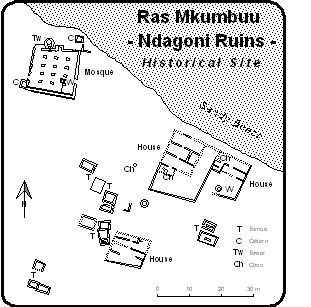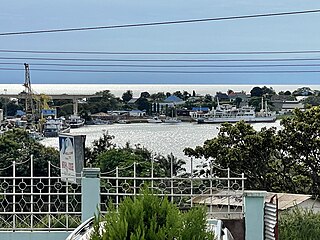Related Research Articles

Swahili, also known by its local name Kiswahili, is a Bantu language spoken by the Swahili people, who are found primarily in Tanzania, Kenya and Mozambique.
The Pokomo people are a Bantu ethnic group of southeastern Kenya. Their population in Kenya was 112,075 in 2019. They are a distinct ethnic group with their own sub-clans/tribes. Despite their proximity, they are not of the nearby Mijikenda people. They are predominantly agriculturalists and both freshwater and ocean fishermen living along the Tana River in Tana River County. They speak the Pokomo language, which is similar to Swahili.

The kanga is a colourful fabric similar to kitenge, but lighter, worn by women and occasionally by men throughout the African Great Lakes region. It is a piece of printed cotton fabric, about 1.5 m by 1 m, often with a border along all four sides, and a central part (mji) which differs in design from the borders. They are sold in pairs, which can then be cut and hemmed to be used as a set.

The Swahili Wikipedia is the Swahili language edition of Wikipedia. It is the largest edition of Wikipedia in a Niger–Congo or Nilo-Saharan language, followed by the Yoruba Wikipedia.
Chimala is an administrative ward in the Mbarali District of the Mbeya Region of Tanzania. In 2016 the Tanzania National Bureau of Statistics report there were 18,332 people in the ward, from 16,633 in 2012.

Monduli Mjini is an administrative ward and district capital located in the Monduli District of the Arusha Region of Tanzania.The ward is totally surrounded by the Engototo ward. In 2016 the Tanzania National Bureau of Statistics report there were 8,699 people in the ward, from 7,796 in 2012. The average elevation of Monduli Mjini is 1,553m.
Chambani is a historic site and village located in Mkoani District of Pemba South Region. Its one of several National Historic sites on the island of Pemba. The site is located nine kilometres south of Chake-Chake, close to several sets of ruins, notably the Pujini Ruins, a 15th-century citadel, located close to the village of Pujini, two kilometres to the north.

Ras Mkumbuu Ruins are located in Chake Chake district of South Pemba Region. They lie close to the village of Ndagoni at the end of a long narrow peninsula known as Ras Mkumbuu, which lies to the northwest of the town of Chake-Chake. The ruins mainly date from the 9th century CE and were abandoned in the 16th century, though there are indications that they were built over older foundations. Notable among these ruins are those of a large mosque which was for some time the largest structure of its type in sub-Saharan Africa. James Kirkman, the first archeologist to excavate here in the 1950s, proposed to connect his findings with the "Qanbalu" mentioned by the Arab explorer Al-Masudi around 900 but could not identify remnants earlier than the 13th century . A possible identification of Pemba Island as a whole and especially Ras Mkumbuu with Qanbalu is still discussed.
Nduli is an administrative ward in the Iringa Rural district of the Iringa Region of Tanzania. In 2016 the Tanzania National Bureau of Statistics report there were 6,933 people in the ward, from 6,626 in 2012.

Morogoro Urban District is one of the six districts of the Morogoro Region of Tanzania. It contains the city Morogoro, capital of the Morogoro Region, and no villages. Morogoro Urban District covers 260 square kilometres (100 sq mi). It is bordered to the east and south by the Morogoro Rural District and to the north and west by Mvomero District

Muheza is a town and capital of Muheza District in the Tanga Region of Tanzania. In the Muheza district, the town covers five wards; Majengo ward to the east, Tanganyika ward to the north, Genge and Majengo ward to the east, and Kwemkabala ward to the west. Paved trunk road T13 from Segera to the Kenyan border passes through Muheza town. The town also has a station on the Tanga-Arusha Railway.

Mkama Ndume Ruins was a medieval Swahili settlement palace ruins located in Chake Chake District of Pemba South Region that was abandoned in the 16th Century prior to Portuguese arrival and is known for its fortification. The site is located 10 km (6.2 mi) east of the town of Chake-Chake. The settlement was ruled by a leader named Mohammed bin Abdul Rahman, who was known for his cruelty towards his subjects thus earned his infamous nickname Mkama Ndume meaning milker of men in old Swahili. The settlement ruins bear this nickname.

Kigoma is an administrative ward in Kigoma-Ujiji District of Kigoma Region in Tanzania. The ward covers an area of 4 km2 (1.5 sq mi), and has an average elevation of 789 m (2,589 ft). In 2016 the Tanzania National Bureau of Statistics report there were 7,604 people in the ward, from 6,908 in 2012.

Kilwa Kivinje Historic Site is protected historic site located on Kilwa Kivinje ward in Kilwa District in Lindi Region of Tanzania's Indian Ocean coast. The site is home to medieval Swahili ruins and some surviving Swahili buildings from the late 19th century. The settlement is considered to be the refuge of the earlier inhabitants of Kilwa Kisiwani who had fled Vasco da Gama sacking of the city in 1505 and also absorbed more refugees fleeing the Madagascar pirates in 1822.

Pujini Ruins is a Medieval historic site next to the village of Pujini located in Chake Chake District of Pemba South Region. There used to be a fortified palace at the site, only ruins of the walls remain. The palace is believed to have been of Mkame Mdume. Its one of several National Historic Sites on the island of Pemba including Chambani and Ras Mkumbuu.

Chwaka is a medieval Swahili historic site next to the village of Chwaka located in Micheweni District of Pemba North Region, Tanzania. There is an excavated Swahili mosque on the site. The location of these ruins is 6 km (3.7 mi) from the small town of Konde, at the end of a trail that extends 900 m (3,000 ft) in the direction of the village of Tumbe on the way to the village of Myumoni.
Tumbe is an early Medieval Swahili historic site next to the village of Tumbe located in Micheweni District of Pemba North Region. Between 600 and 1000 AD, the city of Tumbe served as the island's primary location. There is sufficient evidence that this city served as a major commerce hub for the Indian Ocean. Smaller sites from the eighth to tenth centuries AD were grouped together around the major metropolis.
Shamiani is protected historic site located inside Mkoani District of Pemba South Region in Tanzania. The site is home to partially excavated abandoned medieval Swahili ruins with a brief occupation period from about 14th to 16th century.
Kichokochwe is protected historic site located inside Wete District of Pemba North Region in Tanzania. The site is home to partially excavated abandoned late medieval Swahili ruins, with a mosque and tombs.
Mkia wa Ng'ombe Ruins is protected historic site located inside Micheweni District of Pemba North Region in Tanzania. The settlement was established around the 15th CE and abandoned in the 16th century. There are ruins of a mosque, tombs and some stone buildings. The site is critically endangered to further erosion.
References
- ↑ Pilcher, Tim and Brad Brooks. (Foreword: Dave Gibbons). The Essential Guide to World Comics. Collins and Brown . 2005. 296.